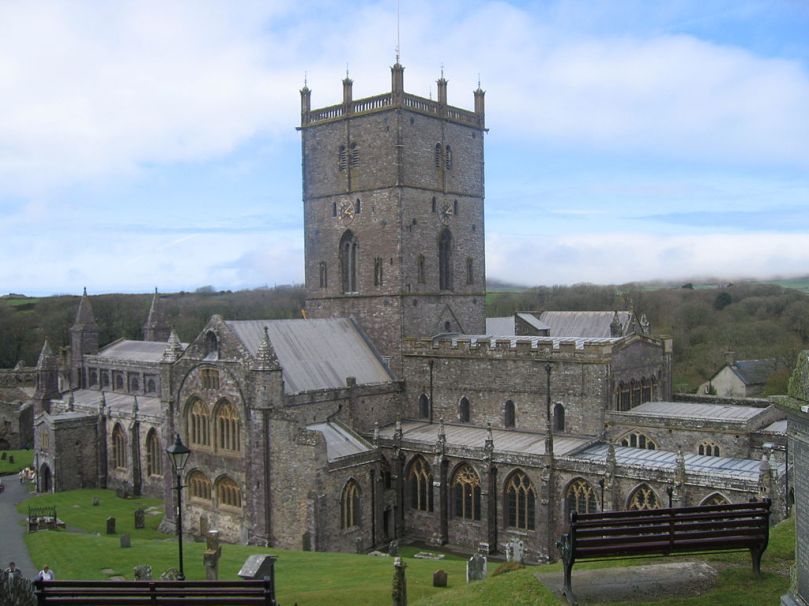
David was a native of Wales and we know quite a lot about his life due to a hagiography written about him in the late eleventh century. He was a Welsh bishop of Menevia and became a renowned teacher and preacher, founding monastic settlements and churches in Wales, Brittany and other places. A monastic community was founded by David before he died in AD 589 in the Glyn Rhosyn valley of Pembrokeshire. He was later named a saint and is the patron saint of Wales. St. David was buried in St. David’s Cathedral and his shrine was a popular place of pilgrimage during the Middle Ages.

During the years between 645 and 1097, the monastery was attacked many times by raiders, including the Vikings who removed St. David’s shrine and all precious metal adornments. The monastery was renowned as a religious and intellectual center during this time and King Alfred the Great called on the teachers of the monastery at St. David’s for help in rebuilding the scholarly life of the Kingdom of Wessex. In 893, one of the monks of St. David’s, Bishop Asser, travelled to Wessex and wrote a biography of the King, “The Life of King Alfred”. This is our main source of information for the life of Alfred the Great.
In 1081, William the Conqueror visited St. David’s to pray, thereby recognizing the importance of the community. In 1123, the Bishop of St. David’s requested and received a Papal privilege decreeing that two pilgrimages to St. David’s was equal to one pilgrimage to Rome and three visits equal to one pilgrimage to Jerusalem. Work on a new cathedral began that same year and it was quickly constructed and consecrated in 1131. King Henry II of England visited in 1171 and this increased the popularity of St. David’s leading to the need for a larger cathedral.

Construction of the present cathedral began in 1181 and was completed shortly thereafter. In 1220, the tower collapsed and the building was damaged by an earthquake in 1247. Inadequate foundations and the effects of this earthquake have caused the walls at the west end of the nave to lean outwards. A new shrine to St. David was built in 1275 and the ruined based of this shrine can be seen to this day. More modifications were made to the building in the fourteenth century and in 1365, the Bishop and John of Gaunt (son of King Edward III of England) began building St. Mary’s College and other buildings. From 1530-1540 the wooden nave roof and ceiling were constructed. In 1538, the bishop stripped St. David’s shrine of its jewels and confiscated the saint’s bones to counteract “superstition”.

In 1540, the body of Edmund Tudor, Earl of Richmond and father of King Henry VII of England was taken from the dissolved Greyfriars Priory in Carmarthen to St. David’s and entombed in front of the High Altar. The Commonwealth forces under Oliver Cromwell in the seventeenth century nearly destroyed the cathedral. In 1793, the Welsh architect John Nash was hired to restore the damage that had been done to the West Front during the Commonwealth. His work proved to be substandard and a century later the work was so unstable, the whole building had to be restored. This renovation lasted from 1862-1877. The cathedral has been maintained and some buildings rebuilt since then. Notable visitors to St. David’s include Queen Elizabeth II and the Prince of Wales.
I visited Edmund Tudor’s tomb when I sang at St David’s Cathedral last year.
LikeLike
[…] in beauty the tomb of Queen Elizabeth I. Edmund Tudor, father of King Henry VII is buried in St. David’s Cathedral in […]
LikeLike
My favourite city and my favourite saint. Love this place.
LikeLike
Quite a few of our towers and what-not seem to have tumbled due to earthquakes in the Middle Ages. Or, maybe it was the same earthquake! St David’s shrine was restored in 2012 – there’s a couple of pictures on http://bitaboutbritain.com/st-davids-too-much-beer-and-the-lost-apostrophe/
LikeLiked by 1 person
[…] was buried in the church of the Grey Friars at Carmarthen. His remains were moved to St. David’s Cathedral during the Dissolution of the Monasteries in 1536. His tomb has a brass etching of a young man […]
LikeLike
I didn’t know Wales was subject to earthquakes. You do learn something new every day.
LikeLike
Yes la Dauphin! I’m finding many of these cathedrals suffered from earthquakes. I guess they can happen anywhere.
LikeLike
I didn’t know Wales was subject to earthquakes. You do learn something new every day.
LikeLike